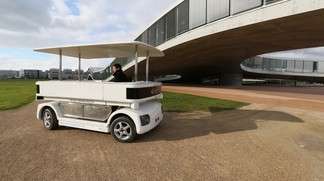A driverless electric shuttle makes its way through the EPFL campus

Created by the French society Induct, Navia shuttles are designed to transport people over the "first and last miles" of a journey. EPFL's Innovation Square hosts a Research and Development team for Induct and will use its first vehicle for education and experiment, before setting up a real transportation service on the campus.
EPFL users might be surprised to see, in the days to come, a small white vehicle wandering around in the campus, possibly with no one on board! The School has acquired the first Navia driverless electric shuttle, created by the French company Induct, whose R&D team just installed offices in the Innovation Square in a research partnership.
Invented in 2009, Navia carries up to eight people at a maximum speed of 20 km/h, and was designed to complement conventional transportation, be it public or private. You could compare it to an elevator operating horizontally: the customer calls for it from a station thanks to a terminal or a smartphone app, steps in, chooses the destination on a touch screen... and can start reading the newspaper while the machine makes its way.
The Navia is fitted with laser telemetry, GPS, 3D cameras and sensors that detect the vehicle's acceleration (accelerometers) and its rotation (gyroscopes) around all three axes (to and fro, side to side, up and down), enabling it to instantly calculate its position, route and distance traveled. It analyses all this information – location, route, and obstacles – in real time. Any perturbation on the way is dealt with by the on-board computer. The vehicle will either stop or avoid the problem. The environement is analyzed ten times per second over 360° and with a 200 meter range. "Under 50 meters, the computer knows if it's faced with a fixed or moving obstacle, calculates its speed and anticipates its route", states Pierre Levèvre, Founder and CEO of Induct.
EPFL: an open-air laboratory for the Navia
To step up its research into induction charging technology and artificial intelligence, Induct decided to work with the Ecole Polytechnique Fédérale de Lausanne (EPFL). The automated electric vehicle will be tested under real operating conditions on the EPFL campus. The research carried out will further the Navia's development and reveal new uses. "Our partnership with Induct enables us to advance our scientific research into induction charging and artificial intelligence, not just in the lab but also outside. This project takes its place in the development of our Innovation District, home to a number of startups in our Science Park. We're delighted to be taking part in this project," says Adrienne Corboud Fumagalli, EPFL's Vice-President for Innovation and Technology Transfer.
Professor Francis-Luc Perret, Vice-President for Planning and Logistics, adds: "As part of its Mobility Plan the EPFL is exploring the most innovative public transport solutions for the "last mile" (and the first). Following a public call for bids issued in 2011, the EPFL has chosen the solution offered by Induct and intends to collaborate to validate this concept with the competent authorities and its long-term implementation."
Provided by Ecole Polytechnique Federale de Lausanne




















